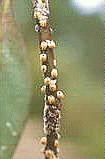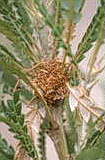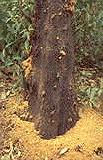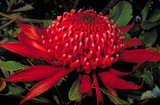|
[Front Page] [Features] [Departments] [SGAP Home Page] [Subscribe]

Pests and Diseases of Australian Plants
Brett Summerill and Eve Steinke
Introduction
To the casual observer many Australian plants when growing in their natural environment appear resistant to the effects of pests and diseases. This, of course, is not the case and most plants at one stage or another are infested with insects or debilitated by various diseases. In fact many plants have adapted to attacks by pests such as leaf defoliating insects as a means of survival. However it is not until these plants are taken from their natural habitat and cultivated that the truly debilitating effects of pests and diseases are observed. This is particularly so where plants are grown in situations in which they are stressed. It is also not until these plants are cultivated for commercial purposes that pests and diseases previously considered insignificant become financially important and necessary to control. Thus the pests and diseases of Australian plants have become an important component of their cultivation.
In this paper we will attempt to give a broad overview of some of the important pest and disease groups attacking Australian plants and some of the control strategies considered appropriate. It is not possible in a paper of this length to exhaustively cover all aspects of this area but more detailed aspects of our research relating to soilborne diseases, particularly those associated with the waratah, will be discussed.
Insect and Mite Pests
Severe insect attacks generally occur in one of two ways. The pest-predator-plant interaction may become unbalanced so that the pest population explodes and causes extensive damage to the plant. Alternatively the pest attack may have a cyclical nature, causing damage on a seasonal basis. Often plants adapt to this latter form of damage in some way and usually survive with minimal long lasting effects. Cultivated plants may either escape insect attack, or, more commonly, suffer greater damage from both naturally occurring and introduced pests. This situation is most common when insect pests are introduced without a full suite of predatory and parasitic organisms or this group are removed via the use of insecticides. Factors which reduce the normal growing activities of the plants, such as root compaction, water logging or inappropriate nutrient application will often predispose plants to the effects of insects and mites, especially sap sucking pests (eg. aphids, scale, mealy bug).

Scale insects attack a wide range of plant species. Select the thumbnail image or highlighted name for a higher resolution image (24k).
The most important considerations in relation to insects and mites thought to cause plant damage are the accurate identification of pests; to have as full an understanding as is possible of the ecology of the pest; and to comprehend how the pest interacts with other organisms especially predators and parasites. This knowledge is particularly essential when considering the control of organisms by the use of pesticides. Failure to fully understand the biology of the pest may result in poor control or even an exacerbation of the situation.
There is a huge array of insects attacking Australian plants and our knowledge is still in its infancy. The following comments give a brief overview of some aspects of some important groups of insect pests.
Sap sucking insects - Those insects which suck on plant nutrients in the sap flow are often associated with the most severe damage seen on plants and are often the most difficult to control. The main groups of sap sucking insects are aphids, mealy bug, scale and mite pests. In many cases these pests arise as the result of external stresses on plants and are common on plants suffering cold stress, nutrient imbalances or some other disturbance. In these cases it is often difficult to control these pests by the use of pesticides and the control achieved in these situations will be transitory. Inappropriate pesticide use may often only enhance the reproductive capabilities of the pest population high by continually removing a proportion of the population. This frequently results in the development of pesticide resistance in an insect population. It is necessary to have a full understanding of the conditions necessary to grow plant species infested by these insects and to recognise those environmental conditions likely to limit plant growth and increase susceptibility of these plants to these insect pests. Plants grown under suitable conditions are less likely to be affected by these insects and predatory and parasitic insects should provide sufficient control of the pests.

Aphids on a Grevillea flower. Select the thumbnail image or highlighted name for a higher resolution image (21k).
Stem and bud boring insects - These insects, mainly the larvae of Lepidoptera and Coleoptera, can be particular problems in native plants grow for the cut flower trade where they can effectively ruin a seasons productivity. Control of this group is difficult as they are not easy to observe, and systemic pesticides are poorly translocated to the active site. Quite often regular applications of systemic insecticides as a preventative measure are necessary to ensure control.

Bud boring insects on the stem of a Dryandra species. Select the thumbnail image or highlighted name for a higher resolution image (27k).

Severe borer attack on the trunk of Acacia parramattensis. In natural stands of this and similar species, borer damage can limit the lifespan of the tree to 10-15 years. Select the thumbnail image or highlighted name for a higher resolution image (51k).
Foliage Diseases
Our understanding of the nature of foliar diseases on Australian plants is limited. It is highly likely that for most Australian plant species there will be a suite of fungal pathogens capable of causing leaf spots, cankers or mildews. Most at this stage are still undescribed taxonomically and their biology and pathology unknown. In most cases these diseases do not warrant control but in rarer cases can cause economic problems in plants grown for floriculture or other horticultural purposes. Generally many of the broader spectrum fungicides used for control of leaf spots are suitable, however these chemicals may require special registration or exemption for their legal use.
Soilborne Fungal Diseases
These diseases are the most regularly blamed cause of death in native plants. However the symptoms of these diseases are often confused with problems such as nutrient imbalances, water logging or deficiencies, poor root aeration or other problems associated with root growth and development. By observing the visual symptoms of these problems it is rarely possible to differentiate the causal agent concerned. Consequently assumptions made regarding the presence of soilborne diseases may often be erroneous. These situations lead to the improper use of pesticides in attempts to control presumed pathogens. The only accurate way to diagnose the presence of a soilborne pathogen is via diagnostic techniques involving isolation of the pathogen and the subsequent identification of the pathogen by trained experts. One of the difficulties involved in the diagnosis and control of soilborne pathogens is the lack of definitive means by which these pathogens can be controlled. A number of fungicides are purported to control specific pathogens but have variable effects depending on the environmental conditions. In addition the lack of accurate diagnostic techniques means that it is difficult to identify the pathogen rapidly and consistently. The situation which all too often occurs is that fungicides are used without accurate pathogen identification and in situations which may be unsuitable for efficacy of the chemical. Thus the wrong fungicide may be used for the wrong pathogen in the wrong situation; so that all that often occurs is that the plant may be adversely affected by the fungicide. It is totally inappropriate to use such fungicides unless you are absolutely sure what, if any, pathogen is affecting the plant in question. If you do not know the nature of the cause of a presumed disease do not use a fungicide to control it, you will only, in the majority of cases, waste your time and money, expose yourself to pesticides and possibly adversely affect the health of the plant.
Given that fungicidal control of soilborne fungal pathogens is for most growers of native plants a dubious approach, what are the prospects for control of these diseases. The two most successful approaches to the control of these diseases are through the use of hygiene practices and by maintaining ideal growing conditions. The avoidance of these diseases has for many years shown itself to be the best approach to control plant losses. Hygiene or "good housekeeping" needs to work at every stage of the propagation and cultivation of all plants. It is particularly important to maintain strict hygiene at the propagation stage; healthy stock plants are essential if diseases are to be avoided. The most important aspects of plant hygiene is the use of pathogen free propagation media, the growing of plants on raised benches and the removal of diseased or potentially diseased plant material as soon as it is observed.
Provision of ideal growing conditions is far more difficult, particularly for plants which have not previously been cultivated extensively. A number of assumptions on growing conditions can often be made from observations on the growth habit of the plant in its natural environment which relate to its temperature range, the type of soils it tolerates (i.e. free draining, acidic etc.), moisture requirements etc. Information on the requirements for mycorrhiza are also important as this may have a critical impact on the vigour of the plant. It is important to remember that the fact that a plant dies or loses vigour does not mean that soilborne pathogens have been at work but rather that the plant may have been stressed by conditions which are totally unsuitable. Our research on the nature of plant deaths in Telopea speciosissima (the waratah) illustrates this point.
Soilborne Diseases of the Waratah
The waratah shows enormous potential for development as a cut flower for both the domestic and export markets. The development of commercial cultivation has, to a considerable extent, been hindered by a number of problems, the most considerable of which has been poor plant establishment and difficulties in cultivation. The poor survival of both seedlings and cuttings has been assumed to be predominantly due to root and crown diseases which result in high plant mortality. A number of species of fungi have been reported to be associated with dead and dying waratahs; these include species of Phytophthora, Pythium, Rhizoctonia, Fusarium, Cylindrocladium and Cylindrocarpon. Some research has shown that Phytophthora cinnamomi and Cylindrocarpon destructans can be pathogenic to waratahs. Cylindrocladium scoparianum has also been shown to be a extremely effective pathogen of a number of horticulturally important species of Banksia as well as the waratah. Diseased waratahs were characterised by a combination of the following symptoms: leaf yellowing, wilting, dieback and drop; progressive blackening and necrosis of the stem; necrosis, blackening and death of roots; few proteoid roots; and in a number of cases, death of the plant.

Telopea speciosissima, the "Waratah" is one of Australia's most valued plants for the cut flower trade. Select the thumbnail image or plant name for a higher resolution image (33k).
Our research has shown that a number of species of fungi are associated with diseased waratahs. Of these a small number i.e., Cylindrocladium scoparium, Rhizoctonia solani, Phytophthora spp. and some strains of Cylindrocarpon destructans, have an ability to cause significant disease, often causing extensive damage or resulting in the rapid death of the plant. However these fungi are rarely isolated from the majority of diseased waratahs and may be considered as occasional, although quite virulent, pathogens of the waratah. The predominant species of fungi isolated are organisms generally recognised as secondary pathogens capable of causing root death and stem cankering of plants under stress. The results of experiments using potted plants indicated that the waratahs succumb to the effects of secondary pathogens only when grown in stressful conditions.
Stress conditions which are significant include nutrition, particularly phosphorus and nitrogen, and moisture. Moderate to high levels of phosphorus and nitrogen, while providing an initial boost to growth were show to be eventually toxic to the plant and to facilitate a number of minor pathogens to attack the plant. High moisture and waterlogging had a similar effect on waratahs. Symptoms that were observed on these plants, blackening of the stem, necrosis of the leaves, cankering etc., were similar to those observed on many diseased plants examined in our laboratory.
Our research indicates that while there are some quite virulent pathogens of the waratah the incidence of disease caused by these plants is relatively minor. What is more common is the incidence of stress induced diseases of the nature mentioned above. It is these type of syndromes that need careful observation to ensure that they are not confused with true pathogen induced diseases.
This article is a reproduction of a paper presented at the SGAP 17th Biennial Seminar, Robert Menzies College, Sydney, 27 September to 1 October 1993.
Dr Brett Summerell has been employed at the Royal Botanic Gardens, Sydney since 1989 as plant pathologist. In this position he is required to diagnose all pest and disease problems in the three gardens which make up the RBG (Mt.Annan, Mt.Tomah and the original gardens in Sydney itself). His research interests have been concentrated on soilborne fungal diseases, particularly those affecting Australian plants.
Eve Steinke is a PhD student at the University of New South Wales. Prior to this she completed a Master of Applied Science degree at the University of Technology, Sydney and the Royal Botanic Gardens on fungi associated with root disease in the New South Wales waratah.
 [Front Page] [Features] [Departments] [SGAP Home Page] [Subscribe]
[Front Page] [Features] [Departments] [SGAP Home Page] [Subscribe]
Australian Plants online - March 1997
The Society for Growing Australian Plants
|